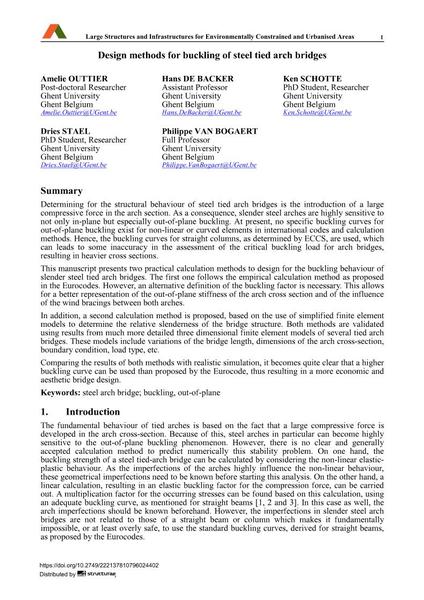Design methods for buckling of steel tied arch bridges

|
|
|||||||||||
Bibliographic Details
| Author(s): |
Amelie Outtier
Hans De Backer Ken Schotte Dries Stael Philippe Van Bogaert |
||||
|---|---|---|---|---|---|
| Medium: | conference paper | ||||
| Language(s): | English | ||||
| Conference: | IABSE Symposium: Large Structures and Infrastructures for Environmentally Constrained and Urbanised Areas, Venice, Italy, 22-24 September 2010 | ||||
| Published in: | IABSE Symposium Venice 2010 | ||||
|
|||||
| Page(s): | 262-263 | ||||
| Total no. of pages: | 8 | ||||
| Year: | 2010 | ||||
| DOI: | 10.2749/222137810796024402 | ||||
| Abstract: |
Determining for the structural behaviour of steel tied arch bridges is the introduction of a large compressive force in the arch section. As a consequence, slender steel arches are highly sensitive to not only in-plane but especially out-of-plane buckling. At present, no specific buckling curves for out-of-plane buckling exist for non-linear or curved elements in international codes and calculation methods. Hence, the buckling curves for straight columns, as determined by ECCS, are used, which can leads to some inaccuracy in the assessment of the critical buckling load for arch bridges, resulting in heavier cross sections. This manuscript presents two practical calculation methods to design for the buckling behaviour of slender steel tied arch bridges. The first one follows the empirical calculation method as proposed in the Eurocodes. However, an alternative definition of the buckling factor is necessary. This allows for a better representation of the out-of-plane stiffness of the arch cross section and of the influence of the wind bracings between both arches. In addition, a second calculation method is proposed, based on the use of simplified finite element models to determine the relative slenderness of the bridge structure. Both methods are validated using results from much more detailed three dimensional finite element models of several tied arch bridges. These models include variations of the bridge length, dimensions of the arch cross-section, boundary condition, load type, etc. Comparing the results of both methods with realistic simulation, it becomes quite clear that a higher buckling curve can be used than proposed by the Eurocode, thus resulting in a more economic and aesthetic bridge design. |
||||
| Keywords: |
buckling out-of-plane steel arch bridge
|
||||
